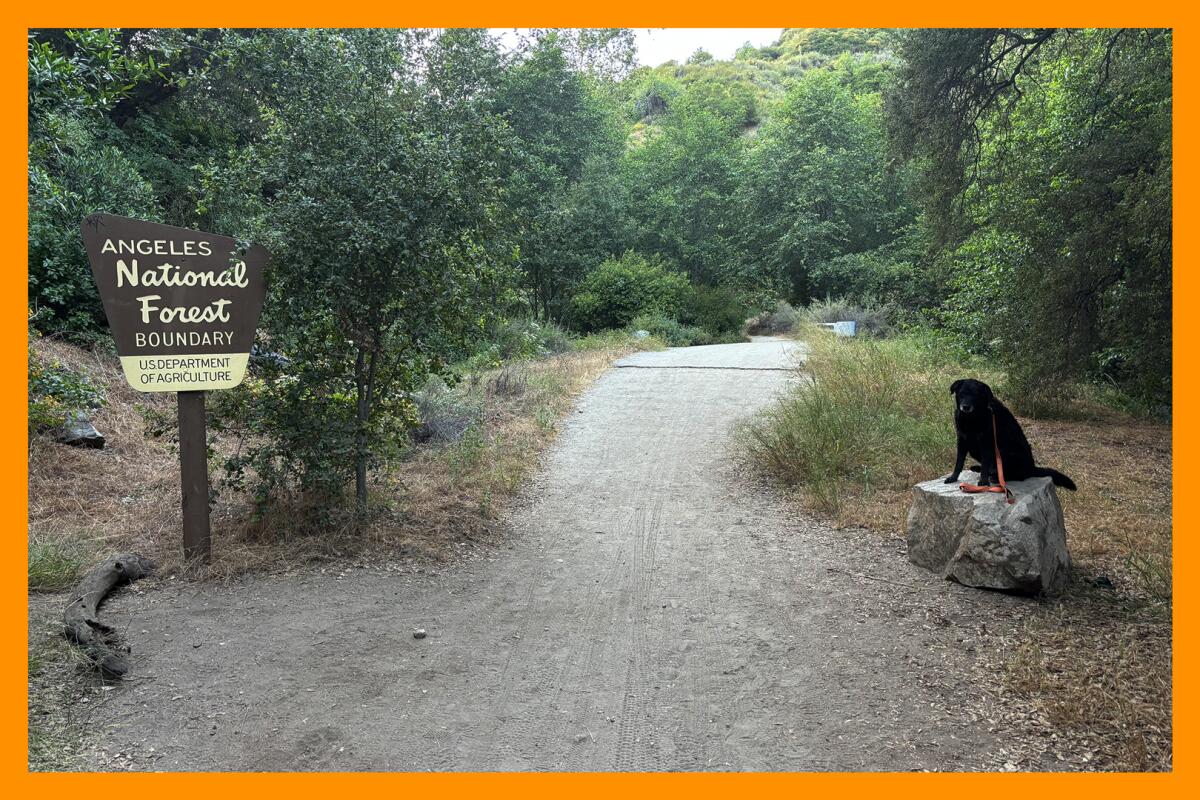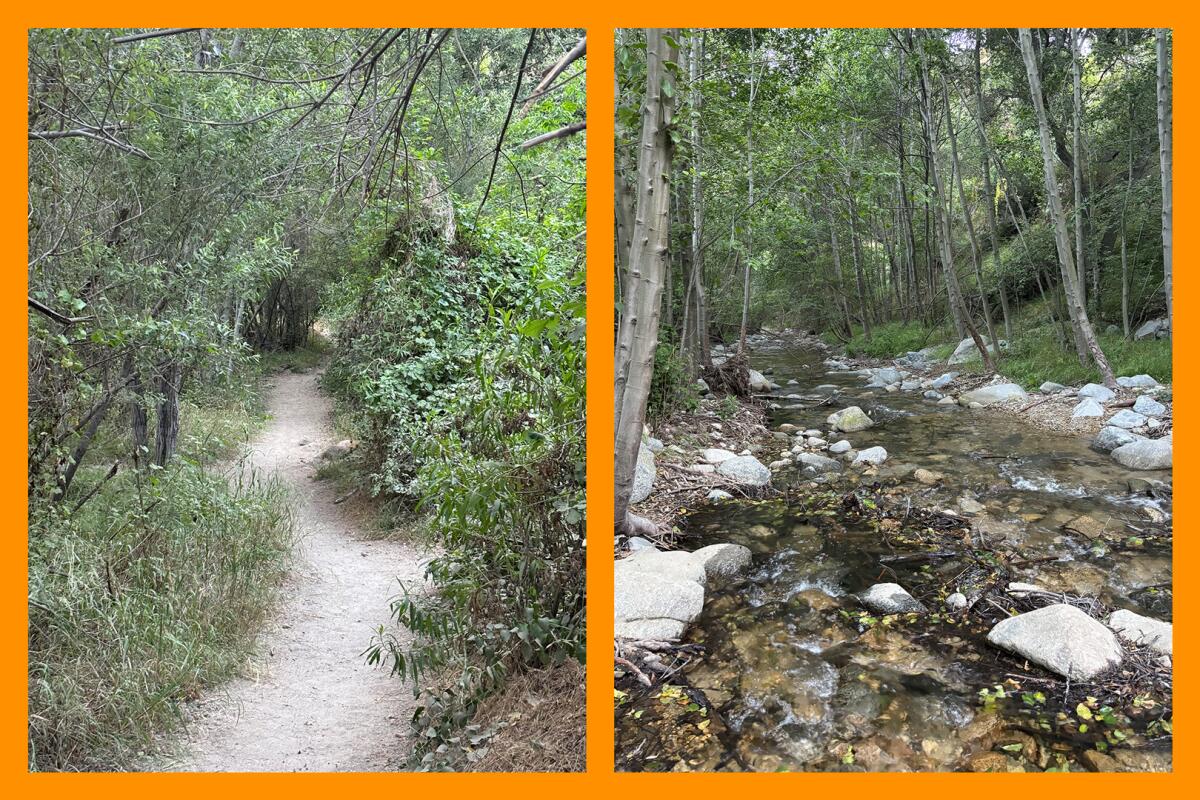Editor’s note: This newsletter is all about featuring a variety of exciting voices from SoCal’s outdoors scene. Starting this month, that voice belongs to Times staff writer Jaclyn Cosgrove, who will write The Wild going forward. Jaclyn enjoys hiking through Angeles National Forest and mountain biking along the least scary trails they can find.
Some trails provide the same sense of comfort that’s found in spending time with a good friend or eating your favorite recipe from home.
That’s how I feel when hiking a section of the Gabrielino National Recreation Trail near Pasadena. I often take it about 7 miles, out and back, splitting off the main trail to check out the Brown Mountain Dam waterfall.

At left: Several coast live oak, including this one with a swing, live along the Gabrielino Trail. Sit beneath one of these majestic trees, and they might just tell you a story. Top right: There are several native plants and wildflowers along the Gabrielino Trail, including golden yarrow. Bottom right: Bush monkey flower, sometimes called sticky monkey-flower, is a native shrub found along the Gabrielino Trail.
(Jaclyn Cosgrove / Los Angeles Times)
If I’ve had a bad or weird day, or maybe I’m just a little bored, I can often be found somewhere along this trail, admiring the laurel sumacs with their taco-shaped leaves, the massive coast live oaks that provide loads of shade and native plants like California buckwheat, sticky monkey-flower and golden yarrow. Sometimes I sit near the Arroyo Seco, a 22-mile natural river, and listen as it flows by.
My dog, Maggie May, and I first visited the trail around 2019. After visiting dozens of times, Maggie now knows the route as well as I do. She knows that after we cross the second bridge over the bubbling Arroyo Seco, we will soon turn for the first water stop.
This trail is good for all ages and fitness levels. Over the last five years, I’ve taken several friends and family members, including anyone visiting from my home state of Oklahoma, to this trail. And now I’d like to introduce you to it.
First, the logistics.

Maggie May, the writer’s dog and hiking companion, poses on a rock at the boundary where the trail enters Angeles National Forest.
(Jaclyn Cosgrove / Los Angeles Times)
The trail starts outside of Angeles National Forest so parking is free.
Some folks park in a small lot by the intersection of North Windsor Avenue and Ventura Street in Altadena. Near this lot, there’s a gate blocking vehicle traffic. This is a helpful spot to enter the trail — which is paved for just under a mile before turning to dirt — if you’re biking or a hiker who uses a wheelchair. (Note: Entering here will extend your hike about 1.4 miles round trip.)
I usually leave this lot for the aforementioned trail users and instead head north on Explorer Road, parking in a large dirt lot near the back entrance of the NASA Jet Propulsion Lab.
From that lot, you can enter the trail up a short, steep paved path. I usually joke to friends that this section will be the hardest part of the entire trail, as most of the route is a gentle incline.
From here, you can walk as long or far as you’d like. You don’t have to make it to the dam waterfall to enjoy yourself.
The path meanders northwest, running alongside the Arroyo Seco, which you will cross multiple times. Along the way, you’ll likely see several western fence lizards, and might spot red-tailed hawks, California towhees and, if you’re lucky, great horned owls. One hiker told me a few months ago he’d even spotted a bear one evening. If leaving near sunset, you’ll enjoy the euphonious song of several frogs and toads croaking to their hearts’ delight.
In terms of effort, overall, you’ll gain less than 700 feet in elevation if you take the trail all the way to the dam.
A few things to keep in mind:
- Your feet will get wet unless you turn around at the first water crossing so plan accordingly.
- Please don’t create your own dams as this harms efforts to reestablish rainbow trout in the river; if a friend builds a dam, please take it down before leaving.
- There’s a new vault toilet at the Gould Mesa campground, about two miles in; if you can’t wait until then, try to walk at least 70 paces from the river, especially if it’s a No. 2 situation.
- It might be worth bringing hiking poles to help with water crossings, and a good travel towel.
- Starting in late summer, the Arroyo Seco may begin to dry up; so get out there to see it rushing while you can!

From left: This section of the Gabrielino Trail, sometimes referred to as the Brown Mountain Dam trail, offers plenty of shade along the way to the dam. At right, the Arroyo Seco, which the Gabrielino Trail runs alongside.
(Jaclyn Cosgrove / Los Angeles Times)
As you walk through this beautiful space, consider all who’ve come before you. The Hahamog’na band of Tongva people, the original residents of the region, lived alongside the Arroyo Seco and had several villages near points of water, until Spanish colonizers arrived in the 1700s and 1800s. They lived around present-day Highland Park, South Pasadena and Pasadena — and likely the land where you parked and will hike along this trail, according to historians.
In the 1920s, there were more than 200 cabins built along the Arroyo Seco from the mouth of the river, near where you park, to a place called Switzer’s Camp, according to the Altadena Historical Society. The cabins were part of the U.S. Forest Service’s “forest summer home initiative,” and one of the most popular areas was along the Arroyo Seco.
But that program came to an end for several reasons, according to the historical society — chief among them the building of the Brown Mountain Dam, which required the cabins’ removal.
The Brown Mountain Dam itself is a point of contention, and river advocates like Tim Brick, executive director of the Stewards of the Arroyo Seco, hope to see its removal someday in the near future.
Brick told me that the Brown Mountain Dam — as pretty as its waterfall may be — is one of several features along the river that inhibits the ability to reestablish rainbow trout in the river.
“We think about the Arroyo Seco as a very important part of the L.A. River, as it’s a major tributary, and if rainbow trout and steelhead trout are going to come back to the L.A. River, they’re going to come from the Arroyo Seco,” Brick said.

The author on their mountain bike during a trip along the Gabrielino Trail.
(Jaclyn Cosgrove / Los Angeles Times)
I enjoy hiking with not only the right supplies but also the context for the place I’m in. I have both for this 7.2-mile hike — and now you do too!
Times editorial library editor Cary Schneider contributed to this report.

3 things to do

Trash piles up along the roadside of the San Gabriel River’s East Fork in the San Gabriel Mountains National Monument last July. Volunteers who attempt to clean it up refer to it as “the east fork toilet.”
(Allen J. Schaben / Los Angeles Times)
1. Help clean up the San Gabriel River near Azusa
On busy summer weekends, as many as 10,000 people might visit the East Fork of the San Gabriel River. Unfortunately, they often leave behind mountains of trash. East Fork’s Golden Preservation will host a cleanup of the area from 7 to 10 a.m. Sunday. The group will meet at the Oaks Picnic Area on East Fork Road in Azusa. Golden Preservation — which has picked up more than 8,505 pounds of trash at the East Fork — will provide gloves, bags and trash grabbers. The organization advises you to bring water and wear clothing you don’t mind getting wet and dirty. To register, send a direct message to @eastforksgoldenpreservation on Instagram. Snacks and lunch will be provided to guests who pre-register.
2. Catch a free movie or concert at an L.A. County park
This summer, L.A. County will host its popular Parks After Dark program at 34 parks. Friends and families are encouraged to check out free summer concerts, movie nights or other free programs. You can be just Ken at one of several screenings of the 2023 “Barbie” movie, enjoy some jazz or rock out to a Beatles tribute band. Find the full list of entertainment here. Bonus: This year’s programming also includes several public pools open late Thursdays through Saturdays.
3. Learn about California’s surf culture in Malibu
Hawaiian Duke Kahanamoku is credited with having introduced surfing in the mid-1920s to early Malibu surfers. Almost 100 years later, the Malibu Arts Commission will celebrate that rich history in “A Tale of a Seaside Town,” a community art exhibition that will feature several local artists. A free opening reception is scheduled for noon Sunday at Malibu City Hall, where guests can enjoy refreshments and live music. RSVPs are not required. The exhibition will be on display at the Malibu City Gallery in City Hall at 23825 Stuart Ranch Road from July 15 through Aug. 23. The gallery will be open weekdays from 8 a.m. to 4 p.m. Admission is free. For more information, visit malibuartsandculture.org.

The must-read

Bathrooms at Roberts Camp in Big Santa Anita Canyon went offline after a flood and debris flow washed away a road that allowed them to be serviced.
(Brian van der Brug / Los Angeles Times)
The good news: One of the most beautiful parts of Angeles National Forest might finally reopen after being severely damaged by the 2020 Bobcat fire. The bad news: There are a lot fewer restrooms available in the Big Santa Anita Canyon area, raising concerns among cabin owners that visitors might make poor choices of where to relieve themselves while visiting. My colleague Lila Seidman has the scoop (sorry!) on the “fecal fears” of folks like cabin owner Justin McInteer who said before the fire closed the area, he would “just go along and pick up s—.” That’s not a hobby anyone would sign up for. Will educating visitors about the principles of “leave no trace” be enough?
Happy adventuring,

P.S.
About a month ago, a Reddit user asked me if I’d look into something: was Angeles National Forest going to sell off parking lots at trailheads to private companies to charge access fees? The concern was raised after Wrightwood-based resort Mountain High posted its new Big Pines parking pass, which the company said “replaces the Forest Service Adventure pass at all of our day-use sites, and trailheads (Vincent Gap & Inspiration Point).” (You can see the full list of where the Big Pines parking pass applies here) I spoke to Matthew Bokach, district ranger for the San Gabriel Mountains National Monument, who told me that forest officials felt a private concessionaire could better manage the Grassy Hollow Visitor Center, which had been hard to staff because of its distance to L.A., and nearby sites. Angeles National Forest has no plans, Bokach said, to contract with private companies for any other parking lots or facilities in the forest. This appears to be a one-off and, in fairness, Mountain High has added some cool recreation opportunities since landing the contract, including kayaking on Jackson Lake. Let’s hope, thanks to the contract, that the area remains pristine and well-managed. Want to know more? Read my post on Reddit.
And, if you’d like to help us learn about more great spots to visit, please consider sharing your favorite hike with my colleague Deborah Vankin. Deborah and a few other staffers, myself included, just finished updating our hiking guide to feature 70 of the best hikes in the L.A. area. What did we miss? Let us know.

